Using Gauges for Troubleshooting
Gauge pressure is the first tool in AC troubleshooting. The table below shows 7 Gauge Readouts that you may encounter. Use the Gauge Readout Tool separately or in combination with the table of Gauge Diagnostics for AC troubleshooting.
Gauge Readout Tool
Normal Conditions
Air in cooling system (insufficient suction)
Defective expansion valve
Excessive refrigerant
Moisture Intrusion
Refrigerant does not circulate
Summary Table of Gauge Diagnostics
Normal Conditions
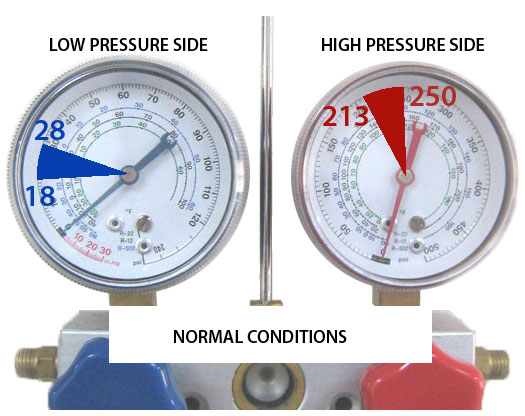
1 Atmosphere
Room Temperatures of 30-38 C (86 - 96 F)
Engine speed of approx. 1500 rpm or about 75% of rated engine speed
Air in cooling system (insufficient suction)
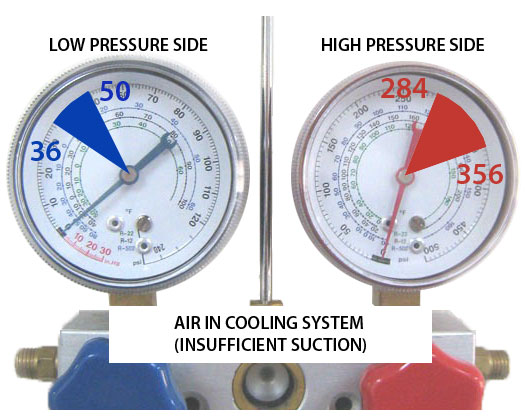
Pressure Range
Low side: 36 to 50 psi
High side: 284 to 356 psi
Indications
Both pressures are TOO HIGH
The low-side piping is not cold
Causes
Air in the system
Remedy
Evacuate the system
Replenish the refrigerant
Check the gauge readings
If prolonged operation with air in the system, the liquid tank must be replaced.
Defective expansion valve
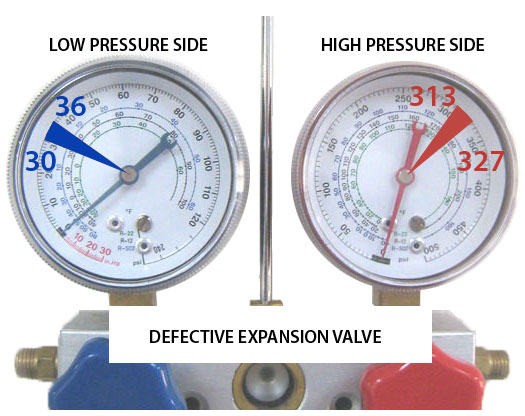
Pressure Range
Low side: 30 to 36 psi
High side: 313 to 327 psi
Indications
Both pressures are TOO HIGH
Causes
Improper refrigerant charge
Defective expansion valve
Improper temperature sensor installation
Remedy
Verify refrigerant charge
Check temperature sensor installation and insulation
If the refrigerant charge is okay and the temperature sensor installation and insulation are correct then replace the expansion valve.
Excessive refrigerant
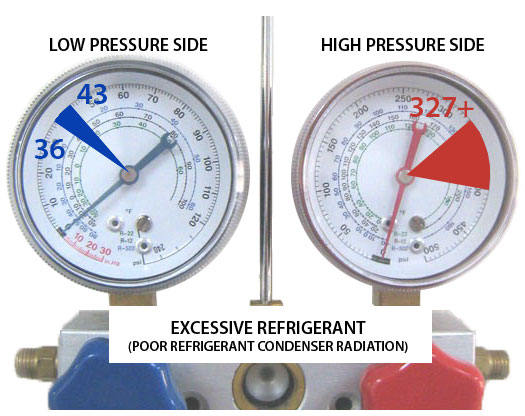
Pressure Range
Low side: 36 to 43 psi
High side: 327+ psi
Indications
Both pressures are TOO HIGH
Causes
Pressure increase due to excessive refrigerant
Insufficient condenser cooling
Remedy
Verify the refrigerant level
Clean the condenser
Check and adjust the fan belt and / or the condenser fan motors
Moisture Intrusion
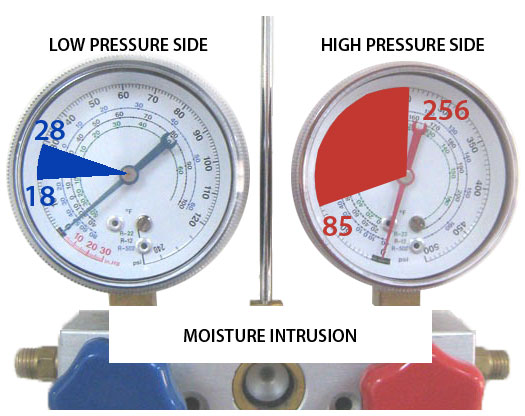
Pressure Range
Low side: 18 to 28 psi
High side: 85 to 256 psi
Indications
Low pressure side alternates between a vacuum and normal pressure
Causes
Moisture has frozen in the air conditioner system, clogging the expansion valve.
Remedy
Evacuate the system
Replace the receiver dryer
Recharge the system
Refrigerant does not circulate
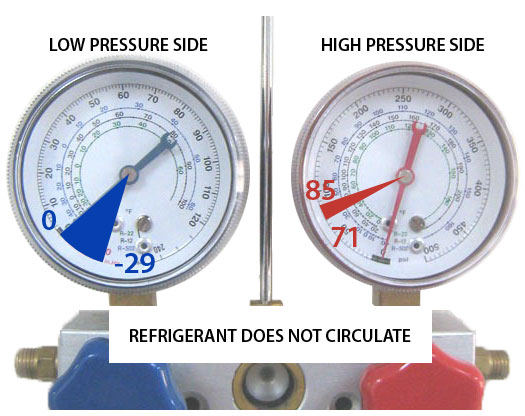
Pressure Range
Low side: 0 to -29.99 psi
High side: 71 to 85 psi
Indications
Low pressure side becomes a vacuum
High pressure as listed above
Frost or condensation on the front and rear pipe connections of the receiver dryer or expansion valve
Causes
AC system is blocked by contamination or ice
AC system is shut off by defective expansion valve or tempeerature sensor
AC line from evaporator to compressor has kink in the line
Remedy
STOP OPERATION IMMEDIATELY
Check for contamination or ice
If moisture is found then evacuate the system
If the expansion valve is defective then replace it
Replace receiver dryer
Recharge with refrigerant to proper level
Repair any kinked hoses
Summary Table of Gauge Diagnostics
Low Pressure Side is TOO HIGH
The low pressure side normally becomes too high when the high pressure side is too high.
| Cause | Inspection | Remedy |
|---|---|---|
| Defective Thermoswitch | The magnetic clutch switch turns off before the outlet air temperature is sufficiently low. | Replace the thermoswitch |
| Poor Expansion Valve temperature sensor contact |
The high and low pressure sides gauge pressures equalize when the magnetic clutch is turned off (within a short time duration) | Replace Compressor |
| Expansion Valve opens too far | Frost has adhered to the suction hose / pipe | Install the temperature sensor against the low pressure pipe and cover with insulating tape. |
| Clogged compressor suction filter | Compressor fitting is cool but the low pressure hose is not. | Remove and clean the filter. |
Low Pressure Side is TOO LOW
| Cause | Inspection | Remedy |
|---|---|---|
| Insufficient Refrigerant | There is little temperature difference between the low and high pressure sides. | Repair any leaks and recharge the refrigerant to the correct levels. |
| Clogged liquid tank (receiver dryer, accumulator) |
Considerable temperature difference between the inlet and outlet sides of the receiver dryer during operation. Also, tank may be frosted | Replace liquid tank (receiver dryer) |
| Clogged expansion valve | Expansion valve inlet side is frosted. Generally the low side pressure is near vacuum. | Replace expansion valve. |
| Expansion valve temperature sensor gas leak (damaged capillary tube, etc..) |
Expansion valve outlet side is chilled and low pressure side is LOW. | Clean or replace expansion valve. |
| Clogged or blocked piping | Low pressure readings decrease or a negative reading is shown. Indicates piping is clogged or blocked between the evaporator coil and the compressor. A frost spot may indicate the point of blockage. | Clean or replace piping. |
| Defective thermoswitch (cold control) |
Evaporator is frozen showing ice along the face of the coil, not just frost on the manifolds of the coil. | Adjust temperature sensing tube to a cooler part of the coil or replace the thermoswitch. |
High Pressure Side is TOO HIGH
| Cause | Inspection | Remedy |
|---|---|---|
| Poor Condenser cooling | Dirty or clogged condenser fins, Cooling fans do not operate correctly. | Clean and / or repair the condenser core / fans. |
| Excessive refrigerant | Verify by gauge reading | Utilize your refrigerant recovery equipment to capture excess refrigerant. Charge to the correct refrigerant levels. |
| Air in the system | Pressure is high on both high and low sides | Evacuate, vacuum and recharge with refrigerant. |
High Pressure Side is TOO LOW
| Cause | Inspection | Remedy |
|---|---|---|
| Insufficient refrigerant | Little temperature difference between the low and high pressures. | Repair any leaks and recharge the refrigerant to the correct levels |


